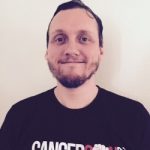How and Why Everyone Needs to Support LGBTQQ Young Adults Who Are Living with Cancer
June 16, 2015
By: Emily Drake
There are many sociological factors that influence the health of populations in North America. These include, but are not limited to: education, physical environment, income, social support, employment, gender, culture and healthy child development. In Canada, we are fortunate to have a universal healthcare system. However, despite this, we see the greatest health disparities among historically marginalized populations, including the LGBTQQ (lesbian, gay, bisexual, transgender, queer and questioning) community. When it comes to queer health both in Canada and internationally, there is little being done in the way of public health efforts to address these issues. Included in this is the young adult cancer movement.
Regardless of age, having cancer is a difficult experience. Living with cancer as a young adult presents unique challenges, such as dealing with reduced or impaired fertility rates, disruptions in education plans, etc. (for more information on this, please see my other articles https://www.huffingtonpost.com/emily-drake/). However, being diagnosed with cancer as a LGBTQQ-identified person, involves other difficulties that include but are not limited to the following:
1. Little information is known about this population’s unique health needs and even less for those who identify as bisexual or transgender.
2. Health care professionals may lack skills or training to adequately meet the needs of the LGBTQQ population.
3. In addition to higher rates of specific cancers, people who identify as LGBTQQ may be at higher risk for depression, suicide, victimization by violent crime, coronary artery disease, substance abuse and stroke.
4. Not disclosing one’s sexual orientation can have a detrimental impact on the person’s mental health.
5. Sexual orientation is rarely considered in large population-based research studies related to chronic illness, making it difficult to compare and understand the determinants of health related to developing chronic illnesses in sexually diverse populations.
Note that the aforementioned health conditions are not caused by sexual diversity, rather they stem from the homophobic, heterosexist and transphobic conditions our society imposes on people. Homophobia is when someone expresses mistrust, hatred or fear to members of the gay community. Heterosexism is the privileging of heterosexuality as the “default” or normative sexual identity and transphobia is when people express prejudice and/or dislike against people who are transgender or transsexual. These conditions exist in health and social services systems. The fact that this happens in health care settings prevents people from receiving both the medical care and psychosocial (psychological and social) support that they need and deserve. Fear of victimization within the health care setting can cause people to withhold important and vital health information (gender identity and sexual orientation) and/or not seek out the care that they need. This can then lead to delays in obtaining both early screening and appropriate follow-up care.
Recently, I attended the Young Survival Coalition’s (youngsurvival.org) conference for young women affected by breast cancer and their supporters. While lesbian and heterosexual women do not differ in either physiological or genetic ways, research has found that lesbians and similarly, women who partner with women, both have an increased risk of developing breast cancer than other women. It is currently believed that the difference, as mentioned above, is due to social stressors (the stigma and stress of homophobia and discrimination). Lesbians are also often diagnosed at later stages due to the multiple barriers they face in accessing primary care.
At the YSC conference, Aurora Harris, of the Lesbian Health Initiative (LHI) of Houston, facilitated a session for young lesbians and their partners to connect and discuss relevant issues they were facing. I was honoured to be welcomed and included in the session. The women felt that to receive the best health care they had to be open about their sexual identity with their health care providers. My question was: how can we as health care professionals and community organizers support and be inclusive of this population? They gave me some tips on what people can do to support the LGBTQQ population (note: they were aware that I would be publishing this piece). Their tips combined with some research produced the following ten suggestions:
1. Environment plays a role in indicating to someone whether or not it is a safe space. Invest in items that prominently display that you are an inclusive environment – such as a rainbow flag, antidiscrimination policies (that address both sexual orientation and gender identity as grounds for discrimination).
2. Demonstrate signs of inclusivity. Heterosexist language is not okay. Appropriately use the word “partner” rather than “husband,” “wife,” “girlfriend” or “boyfriend.” Also, use pronouns that the person prefers and identifies with (i.e. he, she, them).
3. Do not make the person come out to you repeatedly. Once they have, remember it! Coming out to a health provider can be difficult.
4. Ensure that the person is aware that what they are disclosing to you is confidential.
5. No one is talking about LGBTQQ young adults having cancer. Educate yourself and others.
6. LGBTQQ people do not want to attend just LGBTQQ support programs. Having inclusive programing is essential.
7. Partners need to be supported and should be included in support programming.
8. Stating that there are barriers to accessing health care is not enough. There needs to be action. There are problems (barriers) – what can people do about them?
9. The whole LGBTQQ community cannot be lumped into one pamphlet. Education materials should be specific to the population that is being addressed, as each has unique health issues.
10. Fertility services need to equally be referred to LGBTQQ patients, regardless of whether they present with a partner or not, or who that partner is.
Feeling the need to hide one’s sexual orientation can lead to social isolation and one of the biggest things the young adult cancer movement has been working toward is breaking the isolation of having young adult cancer. Given the aforementioned points, it is incredibly important that we all recognize (whether we are LGBTQQ or not) that these are issues and work toward the inclusion of all invisible minorities in the young adult movement. Regardless of sexual orientation, all young adults living with cancer need appropriate medical care and support, but this won’t happen unless we all rally and support everyone, equally.
The American Cancer Society recommendation is for women in their 20s and 30s to have a clinical breast exam done as part of a regular check-up by a health professional, preferably every 3 years. Women should know how their breasts normally look and feel and report any changes to a health professional right away. For more information on this topic please visit cancer.org and one of my previous published articles (https://emilymurray.cgpublisher.com/product/pub.198/prod.69)
This entry was written in English and was originally posted May 22, 2015 on The Huffington Post.
Follow Emily Drake on Twitter: www.twitter.com/EK_Drake





